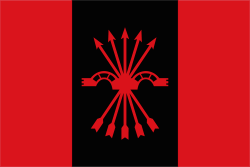Falange Española de las JONS (1976)
Spanish Falange of the Juntas de Ofensiva Nacional-Sindicalista Spanish Phalanx of the Committees for the National-Syndicalist Offensive | |
|---|---|
 | |
| Leader | Norberto Pedro Pico Sanabria |
| Founded | 4 October 1976 |
| Preceded by | FET y de las JONS |
| Headquarters | C/ Carranza 13 2º 28004, Madrid |
| Newspaper | Patria Sindicalista |
| Student wing | Sindicato Español Universitario |
| Ideology |
Falangism Neofascism National syndicalism Spanish nationalism Anticapitalism Third Position |
| Political position | Far-right |
| Colors | |
| Party flag | |
 | |
| Website | |
| www.falange.es | |
| Part of a series on |
| Falangism |
|---|
 |
|
Literature
|
|
Related topics |
| Politics portal |
Falange Española de las JONS (Spanish for "Spanish Phalanx of the Committees for the National-Syndicalist Offensive", FE-JONS) is a Spanish political party registered in 1976, originating from a faction the previous Falange Española Tradicionalista y de las Juntas de Ofensiva Nacional Sindicalista.[1] The word Falange is Spanish for phalanx. Members of the party are called Falangists (Spanish: Falangistas). The main ideological bases of the party are national syndicalism, third positionism and Spanish nationalism.
History
After the death of dictator Francisco Franco in 1975, and coinciding with the period known as the Spanish Transition, a destabilization campaign led by some sectors of the right, trying to repeat the strategy of the 30's, began. Originally, FE-JONS was linked with the neofascist terrorism in Spain, along with other simillar groups.[2] A prominent member of the party was linked with the 1977 Massacre of Atocha. This strategy continued in the following years,[3][4] although the party also participated in elections and fully legal activities. In 1980 an "escuadrilla" (squadron) of the party killed Juan Carlos García Pérez in Ciudad Lineal, Madrid.[5]
After the electoral defeat in the general elections of 1977, in which the candidacies openly defending neo-francoist positions gained less than the 1% of the vote, the party begun a gradual distancing from the Franco regime, highlighting the thoughts of pre-Franco falangists, like José Antonio Primo de Rivera or Ramiro Ledesma.[6] In 1979 the Círculos Doctrinales José Antonio joined the organization, in an attempt to unite neofalangists under a single political party. The same year FE-JONS formed a coalition with Fuerza Nueva and various carlist political organizations called National Union. The coalition gained 1 MP in the elections of that year, gaining 378,964 votes (2.11%). The party didn't participate in the 23-F coup attempt.
Raimundo Fernández-Cuesta, the "National Chief" of the party since its foundation, resigned in 1983. Diego Márquez Horrillo was elected as the new chief the same year. Since then the party fully broke with Francoism, declaring itsef the successor of the originall Falange Española de las JONS, and fully rejecting the "Unification Decree" of 1937.
In 1999 a sector of the party split, forming La Falange. In 2004 the small faction Falange Española Independiente (FEI) joined FE-JONS. In 2011 the organization elected a new national chief, Norberto Pedro Pico Sanabria. Pico was an ex-member of the FEI. In 2012 another small faction, Mesa Nacional Falangista, joined FE-JONS.[7]
Election results
| |
|
|
|
|---|---|---|---|
| Congreso de los Diputados 1977 | 46.548 | 0,25 | - |
| Congreso de los Diputados, 1979 (In the coalition Unión Nacional) | 378.964 | 2,11 | 1 |
| Congreso de los Diputados 1982 | 2.528 | 0,01 | - |
| Congreso de los Diputados 1986 | 43.449 | 0,22 | - |
| European Parliament 1987 | 23.407 | 0,12 | - |
| European Parliament 1989 | 24.340 | 0,15 | - |
| Congreso de los Diputados 1989 | 24.025 | 0,12 | - |
| Congreso de los Diputados 1993 | 8.000 | 0,03 | - |
| European Parliament 1994 | 11.733 | 0,06 | - |
| Congreso de los Diputados 2004 | 12.266 | 0,05 | - |
| European Parliament 2004 | 4.484 | 0,03 | - |
| Congreso de los Diputados 2008 | 14.023 | 0,05 | - |
| European Parliament 2009 | 10.031 | 0,06 | - |
| Congreso de los Diputados 2011 | 2.901 | 0,01 | - |
| European Parliament 2014 | 21.687 | 0,14 | - |
| Congreso de los Diputados 2015 | 7.495 | 0,03 | - |
| Congreso de los Diputados 2016 | 9.862 | 0,04 | |
Symbols
- Yoke and arrows, the symbol of the Catholic Monarchs.
- The blue shirt, a symbol of industrial workers.
- Cara al Sol, "Facing the sun", its anthem.
- A flag with red, black and red vertical stripes.
- The Swan as a symbol of Grand Inquisitor Cisneros (1436–1517) (Universitarian branch).
See also
- FET-JONS
- Falange Española
- JONS
- Falangism in Latin America
- Lebanese Phalanges
- National Radical Camp Falanga
Notes
- ↑ «Nuevo grupo FE de las JONS». El País. 10 de septiembre de 1976.
- ↑ José Luis Rodríguez Jiménez. Los terrorismos en la crisis del franquismo y en la transición política a la democracia. Historia del presente, ISSN 1579-8135, Nº 13, 2009, pages 133-151
- ↑ Violento recorrido por Madrid de una caravana de extrema derecha.
- ↑ Barbarie falangista
- ↑ Diez años de prisión a uno de los implicados en el caso San Bao. Diario ABC, 9 de julio de 1983.
- ↑ Sheelagh M. Ellwood, Paul Preston, Historia de la Falange, p.255.
- ↑ La Mesa Nacional Falangista y FE de las JONS acuerdan integrarse en una misma organización.
External links
| Wikimedia Commons has media related to Falange. |
- (Spanish) Falange Española de las JONS